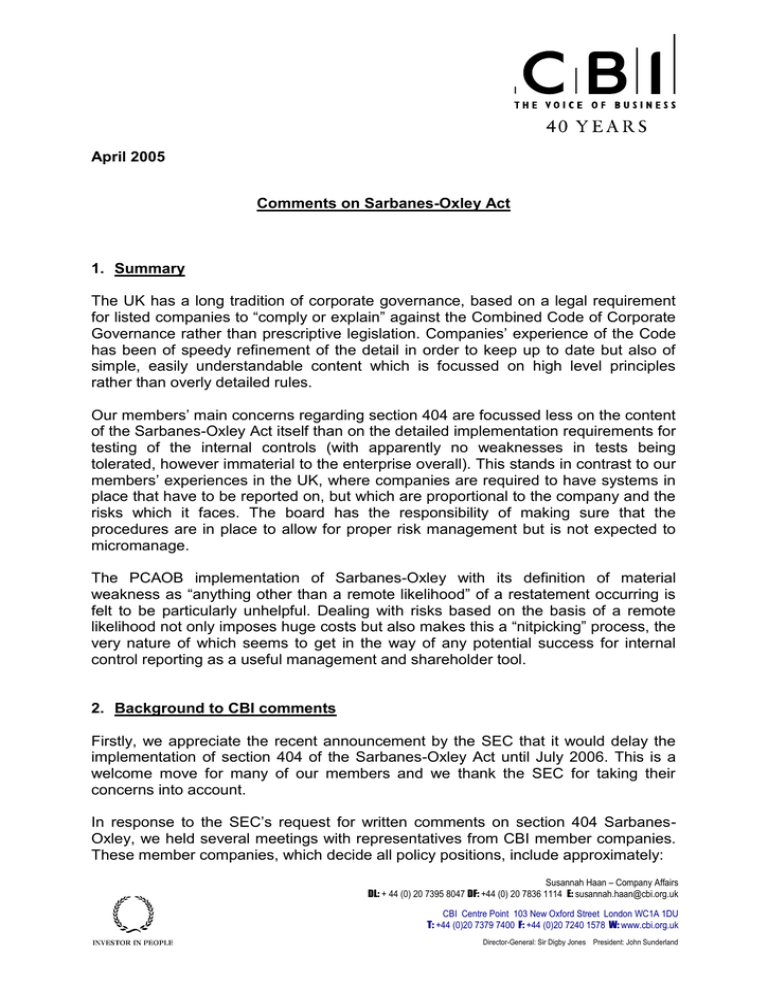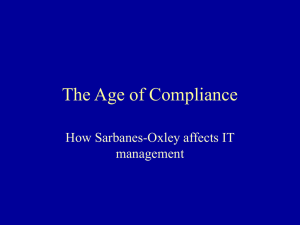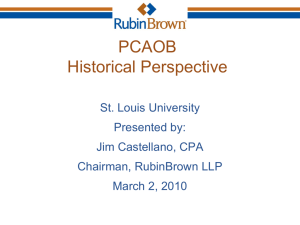The UK has a long tradition of corporate governance, based... for listed companies to “comply or explain” against the Combined... April 2005
advertisement

April 2005 Comments on Sarbanes-Oxley Act 1. Summary The UK has a long tradition of corporate governance, based on a legal requirement for listed companies to “comply or explain” against the Combined Code of Corporate Governance rather than prescriptive legislation. Companies’ experience of the Code has been of speedy refinement of the detail in order to keep up to date but also of simple, easily understandable content which is focussed on high level principles rather than overly detailed rules. Our members’ main concerns regarding section 404 are focussed less on the content of the Sarbanes-Oxley Act itself than on the detailed implementation requirements for testing of the internal controls (with apparently no weaknesses in tests being tolerated, however immaterial to the enterprise overall). This stands in contrast to our members’ experiences in the UK, where companies are required to have systems in place that have to be reported on, but which are proportional to the company and the risks which it faces. The board has the responsibility of making sure that the procedures are in place to allow for proper risk management but is not expected to micromanage. The PCAOB implementation of Sarbanes-Oxley with its definition of material weakness as “anything other than a remote likelihood” of a restatement occurring is felt to be particularly unhelpful. Dealing with risks based on the basis of a remote likelihood not only imposes huge costs but also makes this a “nitpicking” process, the very nature of which seems to get in the way of any potential success for internal control reporting as a useful management and shareholder tool. 2. Background to CBI comments Firstly, we appreciate the recent announcement by the SEC that it would delay the implementation of section 404 of the Sarbanes-Oxley Act until July 2006. This is a welcome move for many of our members and we thank the SEC for taking their concerns into account. In response to the SEC’s request for written comments on section 404 SarbanesOxley, we held several meetings with representatives from CBI member companies. These member companies, which decide all policy positions, include approximately: Susannah Haan – Company Affairs DL: + 44 (0) 20 7395 8047 DF: +44 (0) 20 7836 1114 E: susannah.haan@cbi.org.uk CBI Centre Point 103 New Oxford Street London WC1A 1DU T: +44 (0)20 7379 7400 F: +44 (0)20 7240 1578 W: www.cbi.org.uk Director-General: Sir Digby Jones President: John Sunderland - 80 of the FTSE 100 - 50 US listed companies - major UK investors - some 200,000 small and medium-size firms - more than 20,000 manufacturers - over 150 sectoral associations The CBI is the UK's leading business organisation, speaking for some 240,000 businesses that together employ around a third of the UK’s private sector workforce. With offices in Washington as well as across the UK and in Brussels, the CBI coordinates British business representation around the world. Although not all CBI members are US listed or registered with the SEC, nevertheless Sarbanes-Oxley has affected a wider group of companies because of their relationship with the former companies (e.g. in the event that a bank as a US listed company has invested private equity into a non-listed company, the bank may have to report on such investment and will therefore request Sarbanes-Oxley style information from the unlisted company). 3. Key concerns The CBI strongly supports responsible corporate governance and transparency in disclosure and believes that the Sarbanes-Oxley Act has improved US corporate governance and transparency. However, many of our members have significant concerns about the manner in which section 404 of the Act is being implemented. Our members’ main concerns are: - PCAOB audit standards and guidance implementing the Sarbanes-Oxley Act – these standards, especially AS No. 2, are felt to be contradictory and inconsistent. There is very little commercial perspective or feel for balance as would come from a more principles-based approach similar to the UK Turnbull Guidance (with which our members are also familiar and which they strongly support). The PCAOB’s rules-based approach is exacerbated by the current lack of guidance with respect to these standards, which has caused external auditors to take a very conservative interpretation when applying the standards in practice. - Documentation – the level of documentation required is unrealistic and costly. Even if a company has effective controls in place, it may not have the resources to produce the documentation required to prove this to the satisfaction of the auditors. Neither the companies nor the accountancy firms have the capacity for so much documentation. Greater pragmatism is needed with far less duplication of work by management and the audit firms. - Costs – these are not felt to be proportional to the risk. Companies have already invested significant amounts of money in complying with section 404 requirements but do not feel that the current level of cost or resource is sustainable. There are practical difficulties, which make the current system unsustainable – e.g. there are simply not enough English speakers within the foreign subsidiaries of multinational companies to document all the risks to the degree necessary for compliance with the current PCAOB rules. Despite assurances that the costs will be higher in the first few years of implementation, our members do not believe that these costs will decrease significantly. In the ordinary course of business, companies invest in IT systems, reorganize their operations and personnel and acquire/divest assets. Each of these activities will 2 require internal controls to be modified and retested. The costs will continue to be huge and disproportionate to the benefits, unless changes are made. - Delay in adding shareholder value - a real concern is that Sarbanes-Oxley as implemented is causing companies to delay other commercial projects which would add shareholder value, particularly on the IT side. This is due to both the lack of available resources (in terms of management time and money) and fear of the impact on internal controls. This is a real cost as it threatens the business’ ability to grow and adapt and potentially damages shareholder value. This is related to the issue of: - Regulation versus ownership – companies’ disclosure is being driven by the PCAOB, by the concerns of the audit firms to avoid litigation and by a culture of compliance with rules rather than by focussing on real risks and disclosure of most value to shareholders as owners of the business. - Competitive disadvantage - the general feeling among member companies is that the Sarbanes-Oxley Act puts companies listed in the US markets at a competitive disadvantage compared with their peers that have not chosen to have their securities listed in the US, and that this ultimately harms the long-term interests of investors. 4. Role of the PCAOB Section 404 itself is only a paragraph. The Sarbanes-Oxley Act also gave implementing powers to the PCAOB to create additional, more detailed rules. The specific rules created under the Sarbanes-Oxley Act by the PCAOB have only exacerbated companies’ difficulties. The implementation requires huge amounts of detail and encourages a tick-box mentality, which is unlikely to prevent future corporate failures. The PCAOB’s definition of material weakness refers to “anything other than a remote likelihood” of a restatement occurring. This definition does not seem to us to be consistent with the intention of the Act. Naturally the company’s advisers are reluctant to state that most risks are only a remote likelihood. This means that companies are concerned that they may have to disclose all manner of “weaknesses” which are in reality not perceived as being closely related to the real risks facing the business. The experience of US companies now making their first filings will be important in reviewing this. The PCAOB guidance is felt to be contradictory and inconsistent. There is very little commercial perspective or feel for balance. The IT guidance is felt to be issued late, to be too detailed and often to be confusing. Spreadsheets in particular are “a nightmare” and it is very difficult to find people competent to test the IT controls who are not already in IT. It would appear from the outside that the focus on minutiae has led many US companies to work from the bottom up from detailed lists of risks rather than top down by looking at the key risks to the business and working back to deal with those key risks first. Most investors realise that accounting controls in developing countries are less likely to be as developed as those in the US and other developed countries and that from time to time a subsidiary’s bank reconciliation will not be done properly. Management 3 is sufficiently motivated to promptly investigate and rectify the situation without overinvolvement of the auditors and reporting requirements. Moody’s analysis of companies’ disclosure under section 404 is felt to be far more pragmatic than the PCAOB approach, which forces companies to spend a lot of time and effort on areas which are really not that important and do not present a real risk of failures in financial reporting. The PCAOB approach is a significant concern to EU companies, with the introduction of International Financial Reporting Standards (IFRS). The more fair value based standards of IFRS mean that many reported figures will be more liable to volatility – hence boards will be even less likely to feel comfortable with public statements on effectiveness and even more inclined to be concerned about legal liability. All of this makes dual listings much less attractive. 5. PCAOB registration of audit firms For the audit firms, registration in itself is not a big issue. However, given the manner in which the PCAOB auditing standards are written, the external auditors feel that they have been made judge, jury and executioner of the financial statements. In fact, it should be the job of management to ensure that the financial statements are properly made. The auditors should only be asked to attest to whether the company has followed the auditing standards, not give opinions as to internal control effectiveness and second guess management’s conclusions. Given their position outside the company, the auditors are in a position to review the facts but not to pass judgement as to what material weaknesses are. As a result, the auditors tend to go overboard, with the huge consequences for compliance costs that we see now. The approach being taken by many audit firms is very rules oriented, especially in Germany and Austria, although the UK approach is far less so. Our corporate members’ experience is that the profession in some countries is less able to take a risk oriented view, with greater costs to companies with extensive operations in those countries. Auditors are naturally risk averse (which is what you want to ensure that management does not overinflate earnings) but this means that they are not naturally good at managing risk and are not happy being placed in this position. The audit firms tell us that they feel that the current requirements are detrimental to quality and make discussions with management more defensive. The companies tell us that the new role of the auditors in the US creates a less open atmosphere and chills communication between the audit committee and the auditors, for fear of repercussions if matters are raised with the auditors at too early a stage and the auditors then overreact. Companies would therefore prefer to see the audit firms taken out of the equation. There is an immense amount of work being duplicated by being done firstly by management and then by the auditors. This means that the finance team is being asked the same questions several times by different sets of people, which they see as a waste of their time and effort. What is more important than detailed rules is to ensure the appropriate exercise of power. However, the fundamentals of US corporate governance are still perceived by the outside world to consist of weak shareholder rights, with a lack of investor leverage to prevent corporate greed. Our members do not believe that detailed rules would prevent another Enron, because other factors such as the tone from the top 4 are equally important. However, they are diverting management time away from value adding projects. 6. Effect on management / board One issue which has not received a lot of attention to date is the impact on Directors & Officers’ insurance. Views on premia may change quite radically as the insurers become nervous about compliance. Some companies may find that they cannot obtain such insurance for their directors and officers. The risk of this will be higher for entrepreneurial companies, which could lead to a two-tier system. There is also the issue of recruitment. It is getting more difficult to recruit nonexecutive directors onto boards. To the extent that this relates to a better understanding of their personal risk, this is not necessarily bad. However, the perception clearly is that the risks related to sitting on the board of a company listed in the US are too high. 7. Additional comments: While we appreciate that the SEC has only asked for comments on section 404, we wanted to take the opportunity to make a few additional points. (a) Audit committees In the UK, it is the shareholders in the general meeting rather than the audit committee which appoint the audit firm. We prefer this approach. The definition of financial expert is felt to be too rigid. (b) The UK approach – the Turnbull guidance We welcome the fact that the SEC has recognised the Turnbull guidance as one of three approved frameworks and thought that it might be helpful to give some additional background information based on our members’ experience of both the Turnbull guidance and the Sarbanes-Oxley Act / PCAOB rules. Our members’ view is that the principles-based approach of the Turnbull guidance makes companies think about risk, while the current implementation of the SarbanesOxley Act makes companies think about compliance. It is felt that the Turnbull guidance has changed the culture within companies to encourage better risk management, but without the major additional compliance costs which companies have experienced in the US. (One CBI member alone has already had to spend $100m in compliance with the Sarbanes-Oxley Act. However, the vast majority of our members’ US costs are perceived to be around documentation issues, rather than dealing with the real risks facing the company, which in behavioural terms creates irritation with “stupid” rules and so does not assist compliance with the spirit of the law). UK experience of the Turnbull Guidance Many originally sceptical CBI members have come to realise that the Turnbull guidance is very useful. (As a matter of detail, while the Sarbanes-Oxley Act focuses on financial reporting risk, the Turnbull guidance applies to all risks and controls, not just those related to financial reporting). 5 The main reason for this is the fact that the guidance does not lay down lots of detailed, prescriptive rules, but has set high level principles which are worth rereading and which have positively changed attitudes and the way in which businesses are run. The fact that the Turnbull guidance is relatively short and clearly written means that it is accessible to members of the board, managers, auditors and employees, rather than requiring the assistance in interpretation of lawyers and accountants. This helps to ensure that the responsibility for risk management rests where it should – with the board and management – with the board’s focus on the top few risks, on their own responsibility for processes and on management’s responsibility for implementation. The purpose of the guidance is clearly stated as being to establish a sound system of internal control, which should be treated as part of the normal management and governance processes, rather than as a separate regulatory exercise. This has been important in embedding proper risk management within companies’ culture. The guidance also clearly sets out the fact that internal control systems may reduce, but cannot eliminate, errors, nor provide absolute assurance against fraud or other factors, again enabling the board to emphasise the need to encourage vigilance rather than merely comply with the law. It may be interesting to note that the Turnbull guidance replaced what was known as the Rutteman guidance, which required a statement of effectiveness, with a requirement for a narrative statement. The thought is that companies should have an incentive to publish changes made under Turnbull, since these represent positive news, since the changes have presumably improved the company’s risk management. The requirement for a statement of effectiveness, however, was perceived to lead to fears of litigation, with negative management incentives since companies know they will be penalised for disclosure. Initial difficulties in implementation in the UK When the Turnbull guidance was first introduced, many companies felt they had to establish risk registers and other fairly bureaucratic systems in order to demonstrate to shareholders and regulators that they had appropriate controls and risk management policies in place. There was a lot of activity from consultants and promoters of IT software. However, the focus now is on board decisions rather than IT systems and on common sense and real risks rather than “tick the box” lists. There were initially some compliance costs, but these were insignificant when compared with our members’ US experience, where the costs have been huge. We would be happy to provide further information on any of the points above. 6



